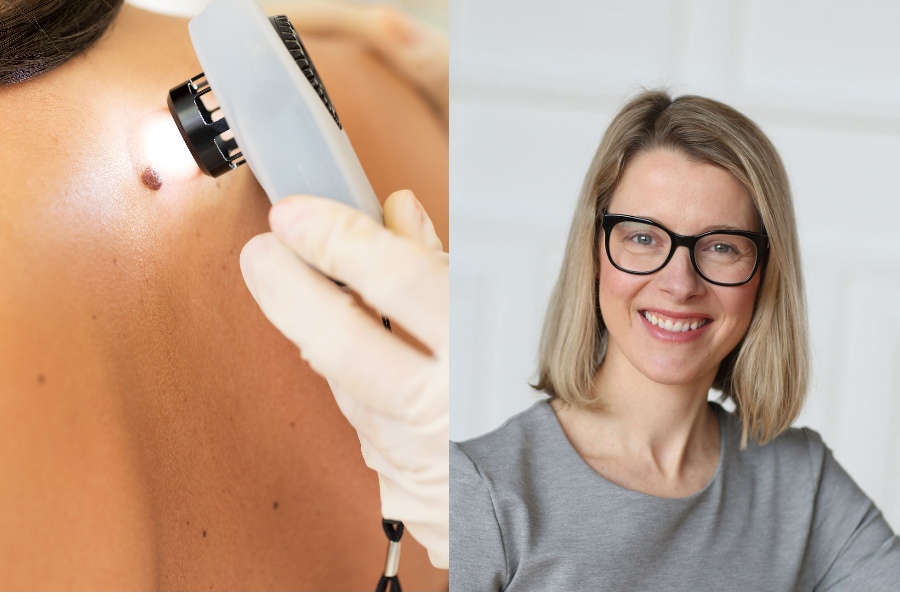
As summer approaches, more people are spending time outside and in the sun. Skin cancer, including melanoma, is one of the most common types of cancer in the United States.
Ingrid Polcari with the University of Minnesota Medical School, M Health Fairview and Masonic Cancer Center answers questions about skin cancer risk factors, treatment options and preventative measures people can take against skin cancer.
Q: What is skin cancer?
Dr. Polcari: Skin cancers are cancerous growths on the skin. Basal cell and squamous cell skin cancers are the most common types and are often curable with surgery, but on rare occasions can also spread. Melanoma is less common than other types of skin cancer, but it’s the most dangerous and can be deadly if it’s not detected early.
Q: What are the primary risk factors for developing skin cancer?
Dr. Polcari: Skin cancers are most common in sun-exposed areas, which should tell you that the sun is a big factor! Sunburns and damage to the skin from cumulative sun exposure, including suntans, increase your overall risk of skin cancer. While your behavior in the sun is one factor, your genetic makeup is also important. For example, people with fair skin and fair or red hair have a much higher risk of developing skin cancer.
Q: What preventative measures can people take against skin cancer?
Dr. Polcari: The easiest way to decrease skin cancer risk is to protect your skin from the sun. Cover your skin with longed-sleeved clothing or swimwear. Wear a wide-brimmed hat to protect your scalp and ears and sunglasses to protect your eyes. Seek shade — or bring shade with you — and plan outdoor activities when the UV index is low. Sunscreen is another way to protect your skin. Look for a product with an SPF of 30 or higher that is labeled as “broad-spectrum.” If you have sensitive skin, choose products with zinc oxide and titanium dioxide. This is also the type I recommend to my youngest patients.
Q: What should people look for when checking themselves for skin cancer?
Dr. Polcari: It’s important to examine your own skin and get to know what’s there so you’re able to detect new growths on the skin or changes in growths that have always been there. Basal cell cancer usually shows up as a shiny bump. Squamous cell cancer is typically a rough or scaly spot that persists. Melanomas are brown or pink growths that arise on normal skin or within an existing mole.
Q: What are you doing to advance skin cancer research?
Dr. Polcari: My research focuses on understanding how we can improve sun protection starting early in childhood to prevent skin cancer development later in life. I am hopeful that during my career we will see the skin cancer statistics start to trend in the right direction — down!
Ingrid Polcari is an associate professor in the University of Minnesota Medical School and a Masonic Cancer Center member. She is also a pediatric dermatologist at M Health Fairview. Her areas of expertise include dermatology, specifically photoprotection and skin cancer prevention.
-30-
About “Talking...with UMN”
“Talking...with UMN” is a resource whereby University of Minnesota faculty answer questions on current and other topics of general interest. Feel free to republish this content. If would like to schedule an interview with the faculty member or have topics you’d like the University of Minnesota to explore for future “Talking...with UMN,” please contact University Public Relations at [email protected].
About the University of Minnesota Medical School
The University of Minnesota Medical School is at the forefront of learning and discovery, transforming medical care and educating the next generation of physicians. Our graduates and faculty produce high-impact biomedical research and advance the practice of medicine. We acknowledge that the U of M Medical School, both the Twin Cities campus and Duluth campus, is located on traditional, ancestral and contemporary lands of the Dakota and the Ojibwe, and scores of other Indigenous people, and we affirm our commitment to tribal communities and their sovereignty as we seek to improve and strengthen our relations with tribal nations. Learn more at med.umn.edu.





